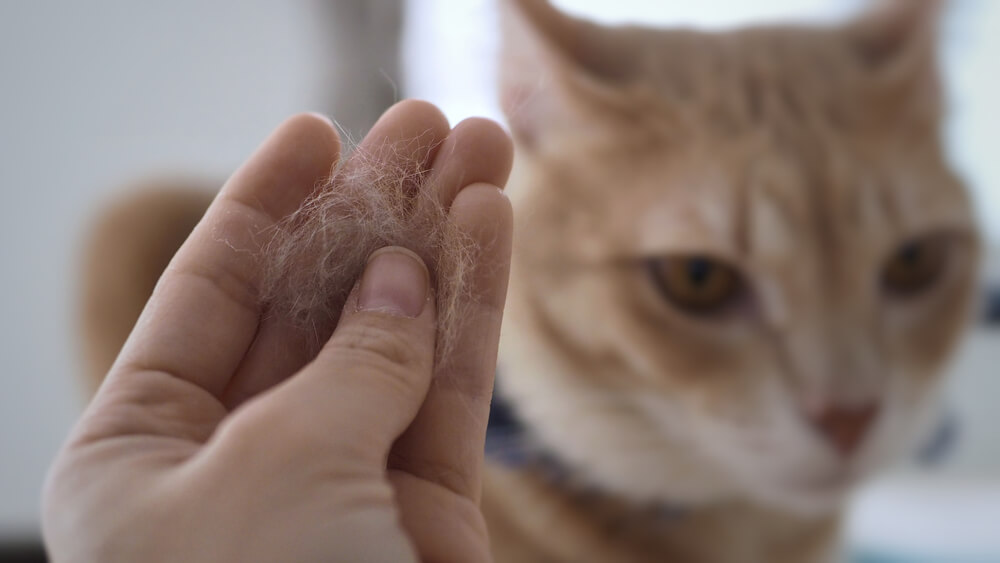
If you find yourself sneezing, having watery eyes, skin rashes, a runny nose, or asthma attacks around cats, then you are likely allergic to cat dander. Cat dander is a normal part of having a cat, but if you have allergic reactions to cat dander, then what?
Fortunately, there are things you can do to minimize cat dander in your home, and subsequently, your own suffering.
What Is Cat Dander and How Does it Look like?
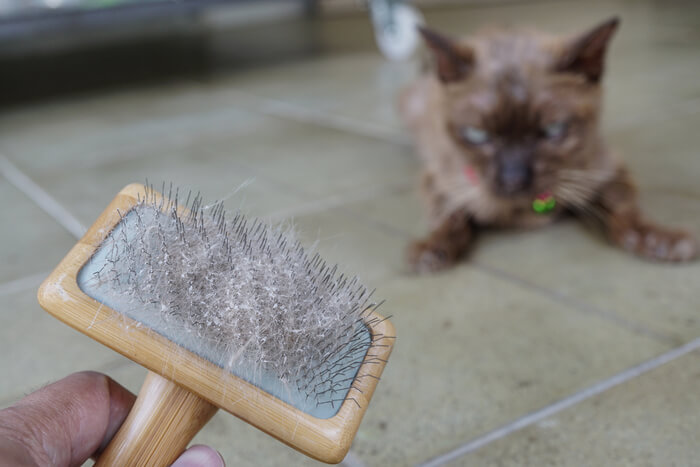
Cat dander is not the same thing as dandruff, which appears as white flakes of skin in your cat’s coat.
Before we get into how to eliminate cat dander, it is important to know that cat dander is the normal dying off and shedding of old skin cells, and it is completely normal in cats. You can’t see cat dander because it is microscopic and cannot be detected by the naked eye.
Cat dander is so small that it floats in the air and hides in upholstered furniture, bedding, and carpet. Cat dander is responsible for the allergies that people have to cats – when you have sneezing or other allergic reaction due to cat allergies, you aren’t reacting to the cat’s fur, you are reacting to the Fel d1 allergens that are present in cat dander.
Cat dander and cat dandruff are not the same. Cat dandruff is little flakes of dry, dead skin cells. You can notice these on your cat, on your clothes after petting your cat, or on furniture or cat bedding.
Dandruff accumulates on cats when they have overly dry skin, when they don’t groom their fur adequately, or when they have a skin disease, skin infection, or internal disorder that results in abnormal shedding of dead skin cells. If you notice that your furry friend is producing dandruff, then it is time to enlist the help of your friendly, local neighborhood veterinarian to determine the cause, and resolve the issue.
Also, skin is the largest organ in the body and the first to suffer if a cat is malnourished. Dandruff may be a sign of inadequate nutrition, so make sure to feed your cat a high quality, complete and balanced cat food that is high in omega 3 fatty acids to ensure good skin health.
Cat Dander and Allergies
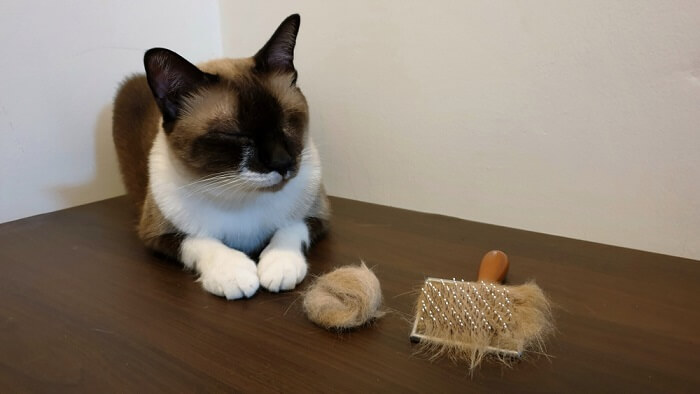
Cat dander, or more specifically, the Fel d1 protein in cat dander, triggers allergic reactions in sensitive people.
Cat allergies in people are common. When you feel your eyes swell up or start sneezing around a cat, you are reacting to cat dander. Specifically, it is your immune system that is reacting to fel d1 allergens.
Every cat produces some level of dander, even non-shedding cats, hairless cats, and cats that have been advertised to be ‘hypoallergenic’ have dander because they have skin!
If you have an allergic reaction, however, don’t despair. There are things you can do to minimize your exposure to dander and hopefully reduce your allergy symptoms.
How To Get Rid of Cat Dander?
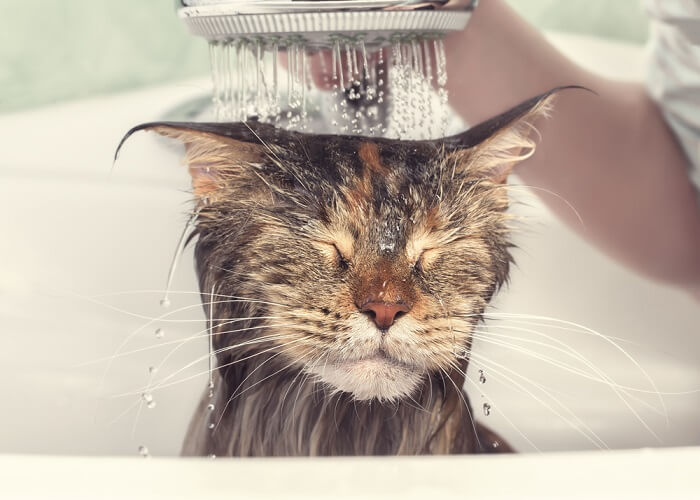
Bathing your cat regularly can help to reduce the amount of dander in your environment.
While you can’t stop the normal turnover of skin cells in a cat’s body (and let’s be honest, why would you?), there are ways to reduce the amount of dander that your cat sheds into your home.
One of the easiest things to remove dander from your cat is groom your cat. Grooming removes excess dander and other pollens and allergens that might cause you to have allergic reactions as well.
And while you may cringe at giving your cat a bath, bathing once a week or once every other week is the best way to reduce cat dander for allergy-sufferers. If you can, start bathing your cat when he or she is a kitten so that your cat is used to it.
Use luke-warm water, a dime-sized amount of mild unscented shampoo, and keep water off your cat’s head and out of eyes, nose, and ears. Do not use hot water or cold water because nobody likes that, and don’t use scented shampoo because it can be very irritating to your cat’s eyes and nose.
Read More: How to Give a Cat a Bath: A Step-by-Step Guide
Do not bathe more often than once a week because excessive bathing can dry the skin out, which can lead to dandruff.
Here are some more bathing tips if you need them:
If your cat hates the bath, then you can try grooming your cat without a bath. Instead, try wiping your cat down with a damp cloth or an unscented baby wipe.
You can also apply dander removal lotion to the cloth. Brushing also removes dander, and you should brush your cat two to three times a week to remove dander from the fur.
How to Reduce Cat Dander

Regularly cleaning the floors, upholstery, and other surfaces in your home will help to reduce the amount of allergens in your home.
The next step in dealing with cat dander is environmental management.
You need to get it out of your home, which can require some deep cleaning – remember that dander is microscopic and can get everywhere.
Fabric surfaces are going to be dander hot spots, so wash bedding, drapes, curtains, and rugs in your clothes washer at least once a month.
You can also use lint rollers to roll your and your cat’s fabric surfaces at least once a week. Don’t forget your cat’s bedding and toys as well!
Dander can linger on hard surfaces as well, so wipe down hard surfaces, such as counters and hardwood floors, with a soapy rag.
Cabinets and walls can also trap dander, so quickly wiping these down at least once a month is also helpful.
If you have carpet, then you have to know that dander is hiding in there. Use a vacuum with a HEPA filter, vacuum at least once a week, and clean your HEPA filter monthly.

Your cat’s litter box is also a prime site for dander accumulation, so you’ll want to clean it regularly to reduce the amount of dander in your home.
The litterbox is prime for accumulating cat dander, so clean it thoroughly at least once a week with hot, soapy water.
It also helps to keep the litterbox in a quiet, out of the way area of the home that you don’t spend a lot of time in, such as a basement or laundry room.
Air filtration can also help.
If you have forced air heating or air conditioning, then change your system’s air filter regularly – every 3 months, and make sure to use HEPA filters that are rated at least MERV 11.
If you have severe cat allergies, you may need an air filter that is rated MERV 13. Allergy sufferers and dedicated cat owners may also want to invest in one or more air purifiers for their home, which clean pet dander and other allergens from the air.
Read More: Best Air Purifiers for Cat Hair, Dander, Allergies, and Odors

Keeping your cat out of your bedroom will help to minimize your exposure to dander and reduce the likelihood of an allergic reaction.
Lastly, if you have cat allergies, don’t let your cat into your bedroom. If you sleep with your cat and you don’t want to change your habits, then wash your bedding and pillows once a week. You may need to consult with an allergist for more tips on how to reduce dander in your home, or how to reduce your own reaction to cat allergens.
Many people find benefit from taking antihistamines, or getting tested for allergies, and then receiving immunotherapy.
Some cat breeds are purported to be hypoallergenic or low shedding. Russian Blues, Balinese, and Siberian cats all shed very little, and produce less of the Fel d1 protein, so one of these cat breeds might be a good option for people with cat allergies.
While cat dander is a normal part of life for any cat owner, there are ways to minimize its impact upon your life.
Frequently Asked Questions
What does cat dander look like?
Cat dander is microscopic dead skin cells that are shed normally by cats every day. Cat dander cannot be seen by the naked eye, and is different that dandruff, which shows up as white flakes that build up on the fur.
How to get rid of dander on my cat
The best ways to reduce dander on your cat is to bathe your cat once a week or every other week. If your cat cannot be bathed, you can also reduce dander on your cat by wiping your cat down with a damp cloth, an unscented baby wipe, or a cloth that has been saturated with dander removal lotion.
How long does cat dander last?
According to the American College of Allergy, Asthma, and Immunology, cat dander can remain in a home up to 20-30 weeks.






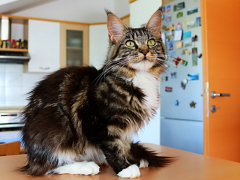

If stuffed animals were in a house with a cat 25 years ago and kept in a closed bin from then til now, would there still be cat dander on them. And if so, could it then just be vacuumed off. I want to give them to a child whose mother is allergic to cat dander. Thank you so much for any thoughts on this.
From what I understand, dander can linger on surfaces for up to 6 months. Twenty-five years should be plenty of time, and you should be just fine to pass the stuffed animals along. Good thinking!
Thanks Mallory!!